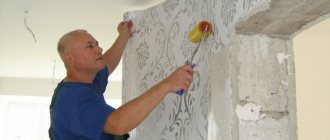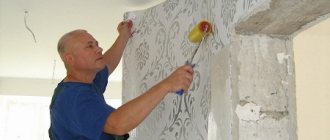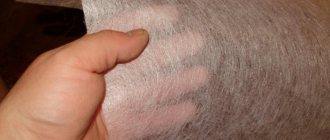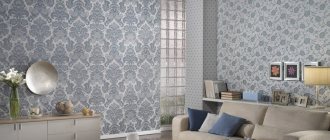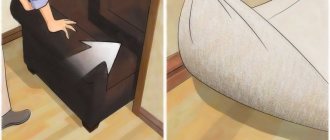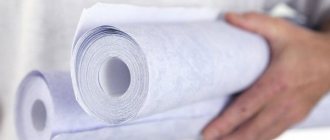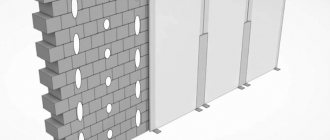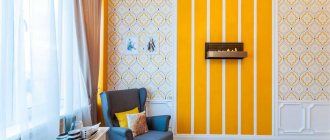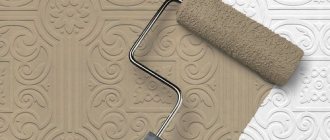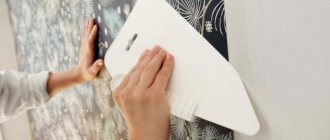Andrey
8668 0 10
Andrey July 28, 2017 Specialization: facade finishing, interior finishing, construction of dachas, garages. Experience of an amateur gardener and gardener. We also have experience in repairing cars and motorcycles. Hobbies: playing the guitar and many other things that I don’t have time for :)
In Soviet times, PVA was often used for gluing wallpaper, but is such a solution justified in our time? To answer this question, I propose to understand all the features of this material, as well as all the pros and cons of its use.
Polyvinyl acetate glue can be used for wallpapering
Main characteristics
Dispersion adhesive consists of small polymer particles mixed with water. When the moisture evaporates, a homogeneous film is formed - polymerization occurs. After this, it cannot be dissolved with water.
Compared to simple wallpaper, this adhesive has significantly higher adhesive strength. These features have pros and cons:
- fairly thick consistency;
- composition features;
- uneven drying.
Spread wallpaper is very difficult to level due to its thick consistency. Thanks to the addition of special components, wallpaper adhesives allow the canvas to slide over the surface being pasted. PVA does not have such properties, so gluing wallpaper on it is quite difficult. It can be used to glue joints.
The adhesive contains rather long cellulose fibers, which do not allow wallpaper to be properly glued to rough and porous surfaces. It is not able to properly fill the pores of the substrate.
PVA is characterized by the fact that it dries for a long time and rather unevenly. Where there is a thin layer of glue, a polymer film forms very quickly. In those places where a thick layer has formed, a film “bag” can be created that does not allow air to pass through well. Therefore, the glue takes quite a long time to dry.
Required tools and materials
Before you start diluting wallpaper glue, you should prepare the tools and materials that you will need for the work. The list includes the following tools and materials:
- The glue itself;
- Container for diluting the mixture with water (basin, bucket);
- Water, take clean water at room temperature;
- Tools for mixing components: construction mixer, stick, drill with mixing attachment.
Before you start diluting wallpaper glue, you should prepare the tools and materials that you will need for the work.
General recommendations
Today there are many different adhesive compositions, specifically designed for certain types of wallpaper or universal, for any financial opportunity. You just need to purchase a suitable one, carefully coat the canvases, paying special attention to the joints, and do not stretch the canvases when gluing.
If you follow all the gluing rules, then you do not need to add PVA to the wallpaper adhesive. It doesn't make high-quality wallpaper turn yellow, but paper wallpaper can, but it becomes tougher. To ensure that the joints do not diverge, and that the heavy wallpaper is glued well, it is necessary to perfectly align the base being pasted - the ceiling or walls. A special paper tape is glued under the joints.
If the walls have previously been painted, they must first be primed, but PVA ensures reliable adhesion. For example, when gluing wallpaper on a non-woven basis, you can add it to the wallpaper glue at about 150 ml/liter.
The worst thing to do is to stick to thick paper ones, where the joints constantly come off. All other types of wallpaper, also dense and heavy, are easy to glue and the joints are secure. Under the seams of wallpaper, you can stick paper strips that are specially produced for this purpose.
Why is it not recommended to glue wallpaper with PVA glue?
Vinyl adhesive can be used for gluing a whole range of wall materials - paper, vinyl, embossed, fabric, velor, metal, bamboo, structural and paintable wood fiber wallpapers. At the same time, the sliding structure of the glue makes it easy to align and accurately match the pattern on the wallpaper. Before the glue dries completely, it is even possible to tear off the wallpaper and re-glue it without adding new glue.
The method of using vinyl adhesive for gluing wallpaper depends on the type of wallpaper itself.
On light paper wallpapers - both single-layer simplex and two-layer duplex - vinyl glue is applied once, and then they are immediately applied to the walls. When choosing heavier wallpaper, some uneven walls or porosity of the base, a different method of wallpapering is used. First, apply a layer of adhesive to the surface of the base and allow it to soak into the walls. Then, after a while, another layer is applied and only after that the wallpaper is glued to the wall.
Vinyl adhesive is used on all types of mineral substrates: concrete, stone, plaster, brick, porous and non-porous substrates. Some types of glue also adhere well to laminate and ceramic tiles.
It is generally expected that these substrates should be cleaned, degreased and dried before adhesive is applied. However, having additional ingredients in its composition, vinyl adhesive is also effective when gluing vinyl, mineral, fiberglass and textile wallpaper and in places of high humidity. Thus, vinyl glue turns out to be a very necessary material when decorating a bathroom or kitchen with wallpaper.
Vinyl adhesive is used not only for finishing rooms with various types of wallpaper. It is also used for interior decoration with various decorative elements. Vinyl adhesive is effective for attaching polystyrene foam moldings and tiles to vertical and horizontal surfaces. In addition, water-dispersion vinyl adhesive is used for gluing composite parquet, panel parquet, laminate and floating parquet. The flooring can be combined with either a base surface or a cork underlay. This adhesive is also used for gluing laminate and veneer.
Vinyl adhesive is very popular in woodworking and furniture production. Transparent, quick-drying adhesive is effectively used for end-to-end jointing of prefabricated furniture, both conventional and intended for wet areas. A reliable adhesive with an aesthetically pleasing end result and ease of use, it is common and available for home use.
Some features
If the wallpaper was glued with regular glue, then you can simply remove it by first separating the top layer.
Then the base can be soaked and easily removed with a spatula. When gluing was carried out using dispersion adhesive, the finishing from the walls had to be scraped off with great difficulty. It is recommended not to do this, because this option is not the best method, as it can damage the surface.
You need to know that after gluing with PVA, it is very difficult to remove the finish. This is a waterproof glue, and wallpaper glued with it cannot simply be soaked and removed from the surface. You have to work with a spatula, damaging the wall covering. If the surface is made of plasterboard, then it will suffer very seriously. In order to obtain a new base suitable for pasting, it will have to be puttied and leveled a lot and for a long time.
PVA is more expensive than regular wallpaper glue, which is more suitable for these purposes. You can add a little dispersion glue (0.5 liters per 10 liters), the wallpaper will stick better and stick more securely. For joints, you can dilute PVA glue with water in the proportion of 2 parts glue and 1 part water. Then it will be easier to apply it to the surface. The adhesive strength is significantly higher than when gluing with simple wallpaper glue.
Important disadvantages
The negative properties of PVA include the following:
- Even professional glue has such a consistency that it does not glide properly like regular wallpaper. Ingredients that promote gliding are specially added to the composition, therefore;
- It dries unevenly and takes quite a long time, it depends on the glue layer, if it turns out to be very thin, then the polymer film forms quickly, immediately after the moisture evaporates. When the layer has formed thick, the resulting film “bag”, which does not allow water or air to pass through, takes quite a long time to dry; simple glue evaporates evenly without forming a film;
- PVA consists of fairly long cellulose fibers and this is how it differs from ordinary wallpaper. It provides reliable fastening as a result of polymerization, but does not glue rough, uneven surfaces well because it is not able to fill large pores in the base;
- after polymerization and drying of PVA, it almost becomes plastic, so it is very difficult to remove wallpaper covered with dispersion glue, because they are securely held in place by a waterproof film.
PVA wallpaper glue exists, but is rare.
conclusions
All of the listed characteristics make this method not a very good method for gluing walls, but sometimes it is still recommended.
- Quite often they resort to this method; if the joints come off, then you should coat the base with the canvas, wait a little until the glue begins to dry. You can press the wallpaper against the wall, it will grab tightly;
- if you plan to glue fairly heavy canvases, then you can add a little dispersion glue to simple wallpaper for absolute reliability. Special PVA for wallpaper is quite rare, it is too expensive and requires learning to work with.
If, after all, there are no options and you need to glue the wallpaper with PVA glue, then it is better to dilute it with water in a ratio of 1:2 or 1:3. To stir thoroughly. It is not recommended to glue wallpaper onto drywall with this glue, even in diluted form. An exception may be non-woven wallpaper. Then you won’t have to prepare the walls before the next gluing; the non-woven base and PVA will do a great job with this.
Some useful information about PVA glue in the video:
Recommended Posts
3d wallpaper for the living room + photo
How to properly glue wallpaper on drywall with and without putty…
How to hang wide wallpaper
Options for wallpapering in the living room, kitchen, bedroom
How to choose two types of wallpaper for the living room
How to glue wallpaper with your own hands
Vinyl glue
Vinyl glue
Vinyl glue is an adhesive widely used for finishing, repair and household purposes. As a rule, it is used for gluing vinyl wallpaper. Given the name of the glue (“vinyl”), many may have the misconception that this product is based on vinyl, or, in other words, based on polyvinyl chloride. However, this is not true.
Let's remember what polyvinyl chloride is. Polyvinyl chloride (or vinyl) has been known to mankind for more than 100 years (polyvinyl chloride was first obtained in 1835 in Germany), but it began to be used on an industrial scale only after 1933, when a patent was received for methods of processing polyvinyl chloride into various products. Since then, vinyl has been used in manufacturing, retail, construction, advertising and other areas. Polyvinyl chloride (often called PVC) is a very common thermoplastic polymer, transparent or white, obtained by processing oil or natural gas and table salt. It has good thermal and electrical insulating properties, is resistant to aggressive chemicals, rotting and decomposition, is harmless to health, does not dissolve in water, and is difficult to dissolve in most organic solvents. All these characteristics make it possible to use PVC for the production of a huge variety of household items for the home, various building materials, and medical equipment.
